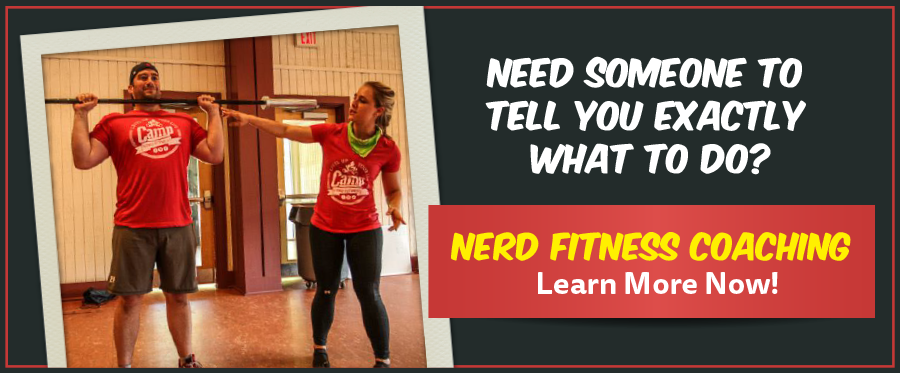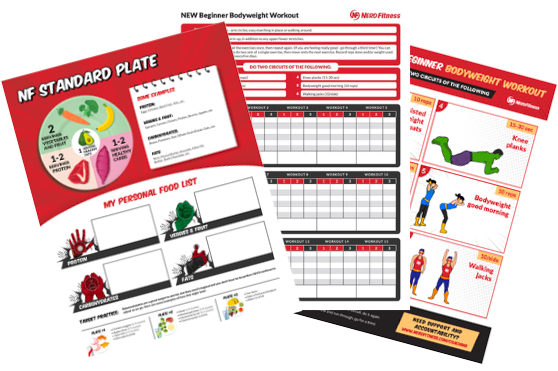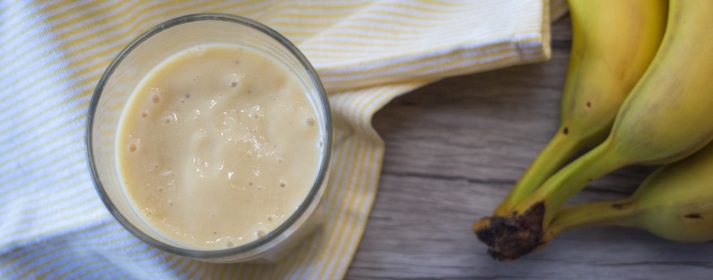
So you wanna start drinking protein shakes, but don’t know where to begin?
You’re in luck, because I’ve been drinking protein shakes for years and today I’m sharing with you all my secrets (ah…most of them).
With Part 2 of our Ultimate Guide to Protein, I’ll teach you:
- Are protein shakes good for you?
- How much protein do I need every day?
- What’s the best protein supplement to buy?
- How to use protein powder
- How to make protein shakes taste better
- Should I drink my protein before or after my workout?
Make sure you also check out Part 1: “How Much Protein Do I Need to Eat Every Day?“
With this knowledge and an awesome blender (which we talk about right here), you can make protein shakes part of your everyday routine.
Alright, let’s get ready to shake things up!
Protein 101: Are Protein Shakes Good For You?

Protein is an essential macronutrient that helps our body rebuild muscle and is an important part of daily nutrition (“duh, Steve,” you say).
You can get protein from any number of real food sources, and you should prioritize real food in your diet (also, “duh Steve”).
Here are some examples of protein-rich food:
- Chicken, duck, other poultry
- Fish
- Meat
- Legumes (beans)
- Eggs
- Quinoa
- Nuts
- Milk
However, there are PLENTY of instances where you might want to also supplement your food with a protein shake or protein powder (here we go):
- You struggle to consume the recommended amount of protein every day (I cover this below!).
- You are a skinny person that needs to bulk up and need more calories in your daily intake!
- You are trying to lose weight and want to replace one unhealthy meal with a meal-replacement protein shake.
- You crave the convenience of a protein shake in place of preparing yet another meal.
In these instances, protein supplements or protein shakes can be awesome!
But don’t just take my word for it. A systematic review of studies revealed:[1]
“Protein supplementation may enhance muscle mass and performance when the training stimulus is adequate.”
Another study showed that among endurance athletes:[2]
“The addition of protein may help to offset muscle damage and promote recovery.”
What this means in regular people terms: If you are strength training correctly and eating the right way, consuming enough protein will help you build muscle and perform better!

He’ll get there.
“Enough protein” in this context can include protein supplements and protein powders.
Just remember that protein shakes are not a panacea for all of your ailments:
- They are NOT required for being healthy.
- But they MIGHT help you lose weight
- They should only SUPPLEMENT (zing!) a healthy diet, not be expected to do all the “heavy lifting.”
You still need to:
- Eat well.
- Follow a strength training routine.
- Getting enough sleep.

If you’re not sure HOW to strength train, don’t worry – I got you covered.
You can download our Strength Training 101 guide when you join the Rebellion (it’s free) and sign up in the box below:
How Much Protein Do I Need Every Day?

This section is taken from our guide “How Much Protein Do I Need to Eat Every Day?“
Despite what advertisements for protein supplements will tell you, you do not need to be eating 500 grams of protein every day.
They like to tell you this so that you use their supplement faster and need to buy more.
Here’s the real deal: claims for the amount of protein the human body needs vary wildly from source to source (and athlete to athlete, and nerd to nerd). You are a unique snowflake and your protein goals should be aligned with your goals.
You want specific numbers, right?

Don’t worry, I got you.
Although the current international Recommended Dietary Allowance (RDA) for protein is 0.4g per pound of bodyweight (0.8 g per kg of body weight),[3] this study[4] shows that this number is too low and should be higher regardless of your body composition.
You just want me to tell you how much to eat, right? I figured.
Well, you’re in luck, because we have a protein calculator you can play with!
THE NERD FITNESS PROTEIN CALCULATOR
On the Metric System? Click here.
Let’s explain some of this a little.
As Examine.com points out in their heavily researched summary on protein:[5]
- If you’re overweight or obese, aim for 1.2–1.5 g/kg (0.54–0.68 g/lb). You do not need to try to figure out your ideal body weight or your lean mass (a.k.a. fat-free mass). Most studies on people with obesity report their findings based on total body weight.
- If you’re of healthy weight, active, and wish to lose fat, aim for 1.8–2.7 g/kg (0.82–1.23 g/lb), skewing toward the higher end of this range as you become leaner or if you increase your caloric deficit (by eating less or exercising more).
- If you’re of healthy weight, active, and wish to build muscle, aim for 1.4–2.4 g/kg (0.64–1.09 g/lb).
- If you’re an experienced lifter on a bulk, intakes up to 3.3 g/kg (1.50 g/lb) may help you minimize fat gain.
These are starter numbers that you can start to experiment around as you see your body transforms.
As Examine points out in its research on protein:[6]
“Higher protein intakes seem to have no negative effects in healthy people.”
So feel free to aim for the higher end of the spectrum, depending on your goals, and adjust from there.
Long story short: Consuming protein is an important part of life for everybody, both the sedentary and the athlete:
- By consuming enough protein while bulking up, you can ensure muscle growth during a bulk with minimal fat gain.
- By consuming enough protein while eating a caloric deficit and strength training, you can maintain the muscle mass you have while losing body fat (you might even be able to build muscle while losing fat simultaneously).
I personally consumed a significant amount of protein (240g of protein at a bodyweight of 190 pounds) during a recent “lean out” phase, and it allowed me to cut body fat while getting stronger and without feeling hungry.
In summary, a major portion of your plate each day should be a source of protein.
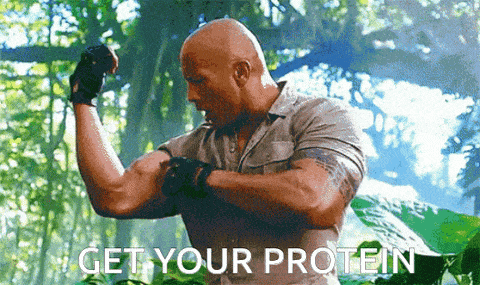
If you are struggling to hit your target protein goal for the day through real food sources, then consider adding a protein supplement.
However, you still need to have:
THEN a protein shake might help you reach your goals a bit faster.
To help busy people like you not waste their time in the gym, and help them actually get results, we created our 1-on-1 Online Coaching Program.
Your NF Coach will build you a custom workout program and provide nutritional guidance for your specific situation.
Find out if we’re a good fit for each other by below:
What’s the Best Protein Supplement to Buy?
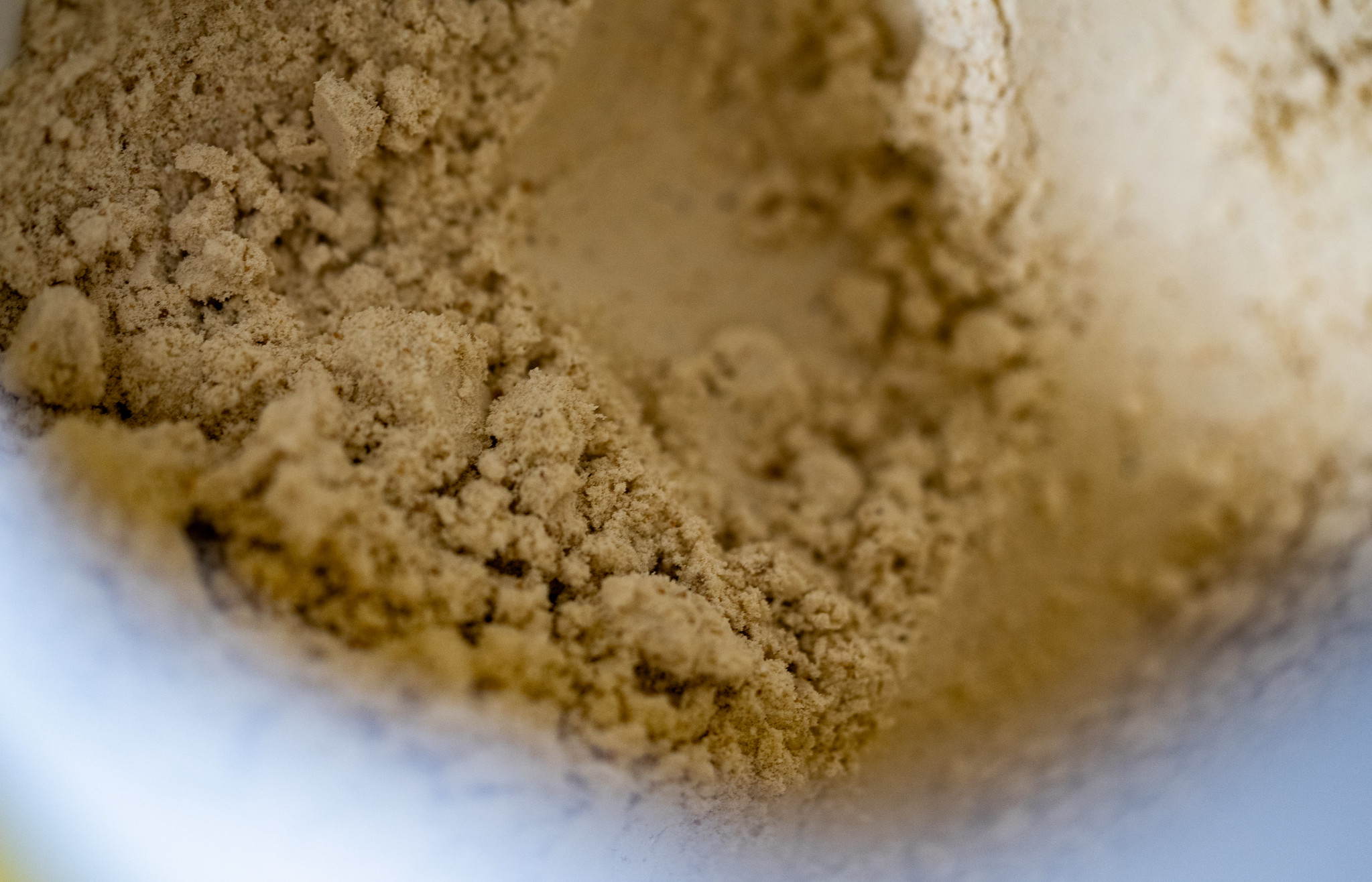 When it comes to buying a protein powder or picking a protein shake, you’re going to encounter a few options:
When it comes to buying a protein powder or picking a protein shake, you’re going to encounter a few options:
1) Whey protein is the most popular, readily available, and cheapest protein supplementation out there. Whey contains all the essential amino acids, and is one of the byproducts of milk that has been curdled and strained. It comes in both “concentrate” and “isolate” forms. Whey is more quickly absorbed by the body compared to its counterpart casein(next), which makes it a great solution right before/after a strength training workout.[7]
2) Casein protein is the other byproduct of milk and also contains all essential amino acids. Because it’s more slowly absorbed by the body than whey, many people consume casein before bed assuming it’ll result in improved muscle growth during sleep! However, this study[8] shows that total consumption of protein during a day is more important than protein timing!
3) Egg protein powders are made from, you guessed it, the protein in eggs – which means they may be a great alternative if you can’t use whey or casein for whatever reason.
Quick recap: whey and casein proteins both come from milk, and both can help rebuild muscle. Whey is more readily absorbed by your body and is usually less expensive than casein, which makes it our preferred form of protein for cost and ease of consumption.
Personally, I prefer whey. I find casein protein less palatable, and it doesn’t mix as well.

Also, don’t worry about timing whey for post-workout and casein for sleep. In my opinion, you’re just overcomplicating things.
Pick the one you enjoy and focus on getting enough protein in a day – that will get you 99.% of the way there to building muscle in the right places!
IF YOU ARE PLANT BASED: these are our recommendations for plant protein powders (from our guide to eating a Plant-Based Diet):
- Pea protein. A solid choice for vegan protein powder comes from peas, specifically the high protein yellow split pea. A quarter cup (28 grams) will get you about 21 grams of protein, and run you about 100 calories. There’s some evidence it might be comparable to whey in building muscle.[9] NAKED Nutrition offers a great 100% pea protein powder you can check out.
- Rice protein. A quarter cup of rice protein will contain 22 grams of protein and run 107 calories. Not too shabby. Plus, when you combine it with pea protein, you’ll end up with a complete amino acid profile needed for human growth.[10] A good brand to look into would be Growing Naturals.
- Hemp protein. While it doesn’t have as much protein as pea or rice (one cup will have 12 grams of protein and 108 calories), what it lacks in this department it makes up for in its nutrient profile. Hemp protein is derived from the seeds of the cannabis plant, but it’s bred in such a way that it won’t have any THC. What it will provide you with though is a decent source of iron, zinc, and omega-3s, which are all things vegans tend to be deficient in. Nutivia sells a good hemp protein if you are interested.
What about Soy Protein? Soy is a complicated beast, though in our opinion the fears around soy are overblown.
As Examine points out in its review of soy protein supplementation:[11]
“Whey protein was absorbed more quickly than soy protein, and stimulated muscle protein synthesis by roughly two times the amount that soy supplementation did. However, no differences in overall body composition was observed between the groups.”
In other words, you do you, boo. If you consume soy and are struggling to hit your protein goals, consuming a soy supplement can help. If you are unsure on soy, consider getting your protein supplementation from any of the other sources above!
Now, regardless of what protein you pick what you need to know about protein shakes based on the collective wisdom of the 15 full-time coaches on Team Nerd Fitness:
- When buying protein powders, buy a product with minimal other ‘stuff.’ Aim for one that starts with “whey protein concentrate” or “whey protein isolate” on the ingredients label, followed by a small number of ingredients – one of which will probably be “artificial or natural flavorings.”
- Pick a flavor that you like! Protein powders generally come in multiple a few flavors: vanilla, chocolate, strawberry, etc. I’m as plain as they come, so vanilla protein is my jam.
- Make sure to look at the ingredients and find one from a reputable brand. Always do your research even if it is one of the most popular brands (such as Muscle Milk). Some of these have had metals such as arsenic found in them.[12]
- Many popular protein powders are just not great in terms of meeting their promises. Check out this lab rating’s review of “high quality” protein powders that meet this Reddit protein powder measurement results thread. There’s a lot of fraudulent stuff out there, so make sure you keep your Sherlock Holmes hat on when shopping!
Steve’s Protein Brand Recommendations
Over the past 15 years of training, I’ve tried dozens of protein powders, and I keep coming back to 2 brands that fit my style and budget:
- Jay Robb’s Grassfed Whey Protein: my current favorite and absolutely delicious (I go with Vanilla)…but VERY expensive. This comes from grass-fed cows, and thus is much more difficult to come by. I find it to be the best mixing protein powder I’ve ever tried, and also the best tasting.
- Optimum Nutrition Whey Protein: The whey I used for years (my former favorite). Optimum Nutrition is well known in the fitness space, and I used their product for close to a decade without issue. If you are on a tighter budget and can’t afford grass-fed whey protein, go with Optimum Nutrition.
How to Use Protein Powder (How Do You Make Protein Shakes Taste Better?)

The back of every protein powder jug will tell you “mixes great with 8 oz of water!”
For some protein powders, this is true.
For others, it’ll taste like you’re choking down recently mixed concrete.
Note: do not consume readily mixed concrete. You’re welcome.
So Step #1 with your newly purchased protein powder is to mix it with water and see how it tastes.
By mixing just the protein and water, you’re adding minimal calories to your daily intake while also increasing your protein intake for the day.
Win.

NOW, depending on your caloric goals or if you’re looking to make a meal replacement shake, you can start to experiment and make your own protein shakes by doing the following:
- Add fruit: bananas, strawberries, blueberries – look for the frozen berry medleys in your grocery store.
- Add a serving of veggies: blend in frozen spinach – you can’t even taste it!
- Try a different liquid: almond milk, reduced-calorie orange juice, skim milk or whole milk.
- Healthy calories: peanut butter, almond butter, cashew butter.
- Seeds like chia seeds or sunflower seeds.
Just pretend like you’re a scientist and you’re creating a different concoction each time. Write down your ingredients and amounts until you find the perfect blend (heyo) of macros and taste that fits your goal!
HUGE CAVEAT: your body still obeys the laws of thermodynamics. Just because you call it a “healthy smoothie” doesn’t mean the 1,000 calories in it don’t count!
If you can’t lose weight, you’re eating too many calories, which means you should be aware of how many calories are going into your quickly-consumed protein shake.
Now, if your goal is bulking up or building muscle – then creating your own high-calorie protein shake is a great way to get extra calories into your day.
I am currently bulking up, so here is my patented post-workout shake that I consume daily (okay it’s not really patented).
STEVE’S POWERBOMB SHAKE
- Ice cold water: 16 oz
- Quaker Oats: 3 servings (120g)
- Whey Protein: 2 servings (62 g)
- Frozen Spinach: 1.5 servings (120g)
- Frozen Berries: .8 servings (120g)
And because we like to have fun around here, we turned the recipe into a fun graphic.
Here’s an infographic for the protein smoothie recipe:
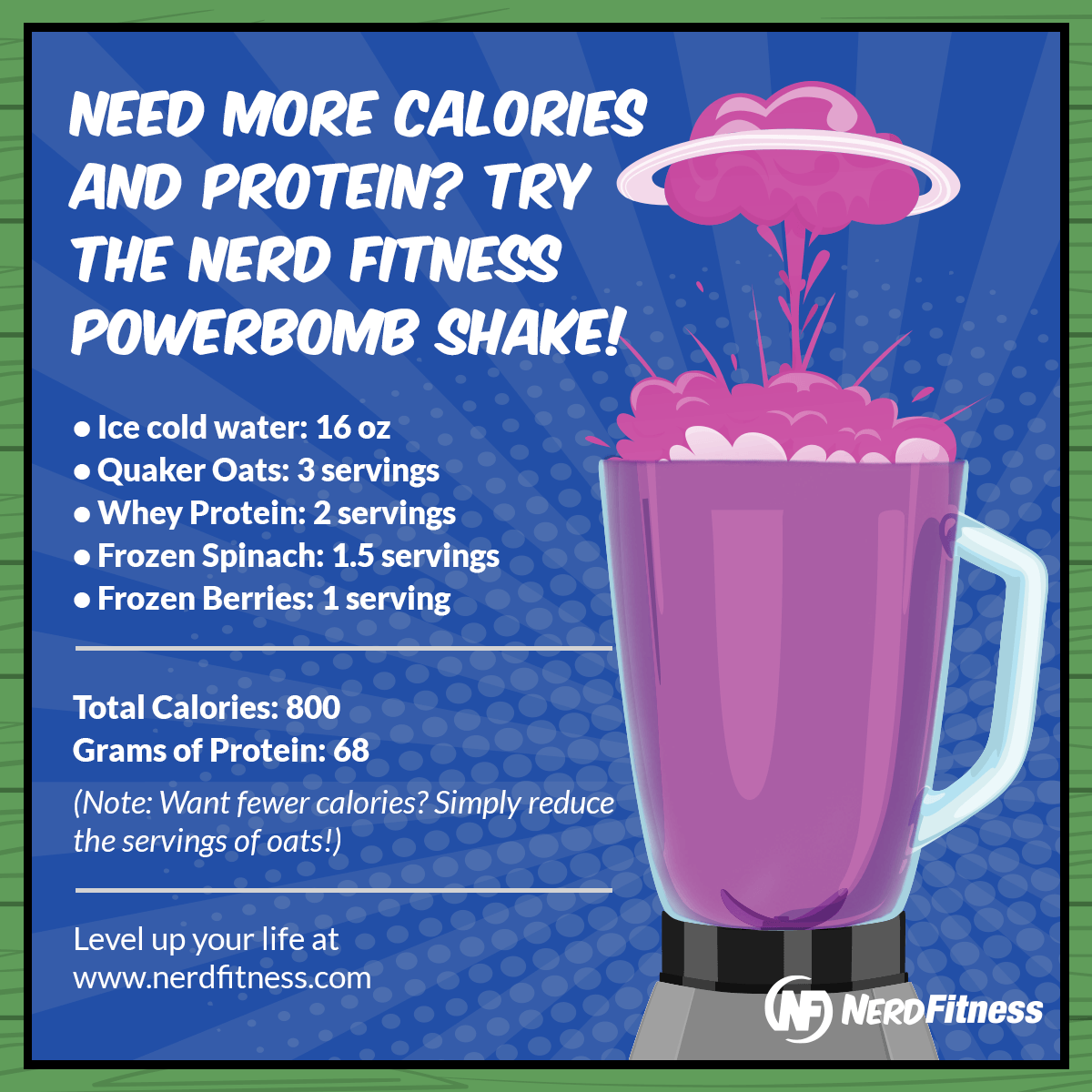
The macronutrient and caloric breakdown of that shake: 795 calories, 68g of protein, 106g of carbs, 13g of fat:

For over a decade, I simply used a cheap blender like this on Amazon!
Depending on your budget, you can also go to your local Walmart, Target, Kroger, Publix, Sam’s Club, Stop & Shop, etc., and buy a blender for 20 bucks.
I will say that as I’ve gotten older and had more disposable income I have become a Vitamix fanboy. They are expensive, but you get what you pay for.
I’ve probably burned the motors out of 10+ cheap blenders, and since switching to a Vitamix it’s been crushing my powerbomb shake ingredients twice a day in seconds.
If you have the money, it’s worth the investment.
Your other option is to buy a cheap shaker bottle
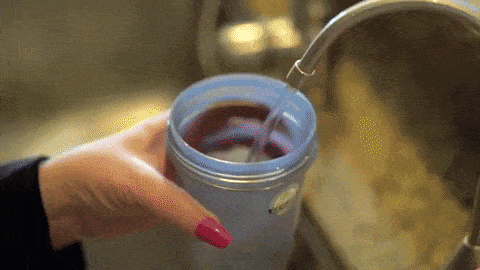
Personally, I’ve found that these things don’t mix nearly as well as a blender, but if you’re traveling with no blender option available, a shaker bottle can be really helpful.
Note: if you are using a shaker bottle, pour the water in first, THEN add the protein shake!
Here’s my “stay healthy while traveling” strategy for protein:
- Measure out 2 servings of protein powder and put them in a sealed plastic bag.
- Put your sealed plastic bag in an empty shaker bottle.
- When ready to consume, remove the plastic bag of protein, then add water to the bottle.
- THEN, add protein.
If you put the protein in first, I can guarantee no amount of shaking will get all of that protein mixed into the liquid!
Should I Drink My Protein Shake Before or After My Workout?
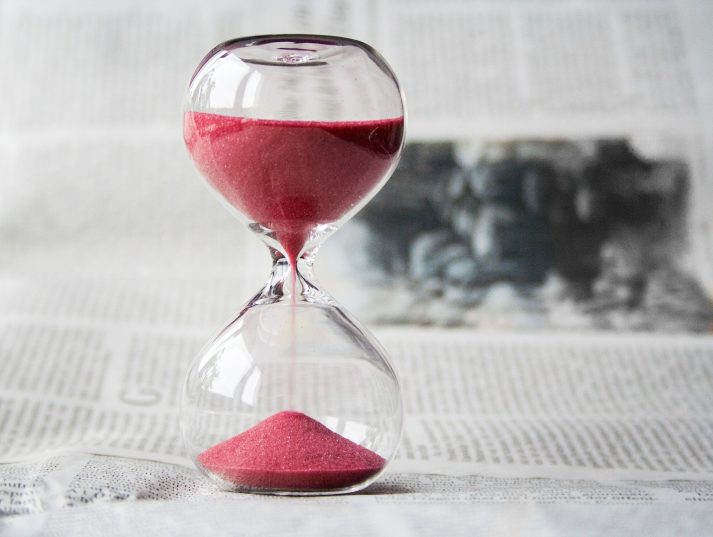
Conventional wisdom tells us that we need to be consuming our protein shake IMMEDIATELY after our workout for maximum gains.
It also tells us that we need to be consuming protein every few hours for maximum protein synthesis by our muscles too.
But what does the science actually say?
According to this abstract:[13]
“In general, protein supplementation pre-AND post-workout increases physical performance, training session recovery, lean body mass, muscle hypertrophy, and strength. Specific gains, differ however based on protein type and amounts.”
And in this study:[14]
“These results refute the commonly held belief that the timing of protein intake in and around a training session is critical to muscular adaptations and indicate that consuming adequate protein in combination with resistance exercise is the key factor for maximizing muscle protein accretion.”
WHAT THIS MEANS: The amount of protein you consume in a day is more important than the timing of your protein when it comes to muscle building. Consuming a protein shake before OR after a workout will result in increased physical performance and muscle hypertrophy – provided you’re training the right way!
If you need to train and then head to work and you can’t eat your protein until later in the day, do what works best for you!
Some people might hate training on an empty stomach, so consuming the protein shake before the workout is beneficial.
I personally train in a fasted state (which we cover in our Guide on Intermittent Fasting), so I don’t consume my protein shake until after my workout.
So, stop worrying about protein timing and instead put your focus on training, total calories, and getting enough protein in the day itself.
Not sure if you’re training right?
Consider working with a Nerd Fitness Coach who can build you a training program and help guide you on your nutrition!
Getting Started Drinking Protein Shakes
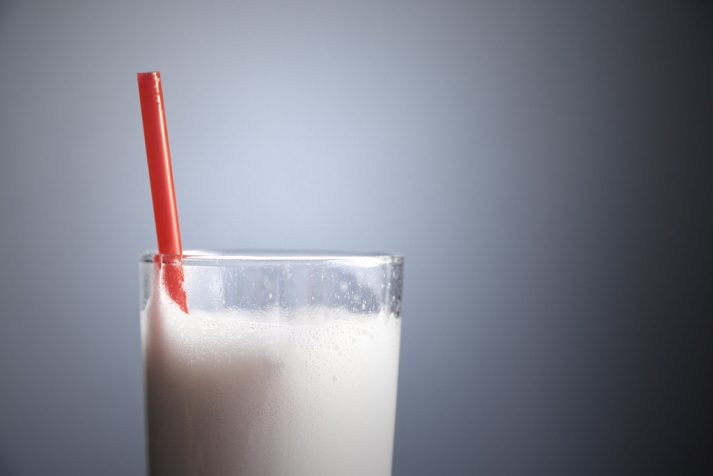
Let’s recap some of the key points of drinking protein shakes for you:
- Protein supplements can SUPPLEMENT a healthy diet, but should not replace it.
- My recommendation is to buy a tub of Optimum Nutrition Whey Protein online if you’re on a tighter budget, in whatever flavor you like.
- If you have more money, consider the Jay Robb’s Grassfed Whey Protein (my favorite).
- Consider mixing in a protein shake before or after your workout. Timing isn’t as important as total protein consumed over the course of a day when it comes to building muscle and recovery.
- Think of a shake as a way to get good protein when you can’t afford/don’t have time to make a good meal.
- A cheap blender will suffice if you don’t have other options, but if you have more of a budget I would recommend getting a Vitamix – you’ll have it for the next 30 years.
Hopefully, this should get you started! Feel free to try out different flavors and combinations of ingredients in your smoothies to make them something you actually look forward to!
Do you have any favorite protein shake recipes?
Any more questions about protein powders and supplements?
Share them with us in the comments!
-Steve
PS: Check out the rest of our protein series:
PPS: Still overwhelmed? Still not sure you’re training right or eating correctly? Want to know which supplements are worth it and which ones are a waste of money?
I hear ya.
These questions and people like you are why we launched our 1-on-1 Coaching Program: to help busy people cut through the noise and just start building muscle, getting leaner, and feeling better.
Click below to schedule a call to learn more:
###
All photo sources are right here[15]

